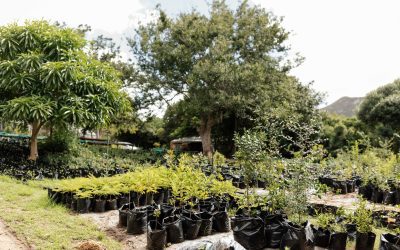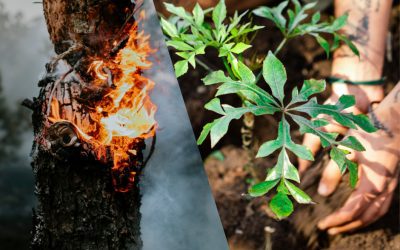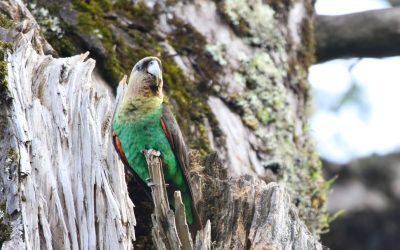That’s a lot to process. Let’s look a little closer. What is FMNR?
- The World Agro Forestry describes FMNR as “a quick, low-cost, sustainable and easy-to-replicate technique to restore and improve agricultural, forested and pasture lands.”
- FMNR also “encourages the systematic re-growth of existing trees and shrubs from tree stumps, roots and seeds. It can be used wherever there are living tree stumps with the ability to coppice [re-sprout] or wherever there are seeds in the soil that will germinate.”
- “FMNR adapts centuries-old methods of woodland management, called ‘coppicing and pollarding’ to produce continuous tree-growth without the need for frequent and costly replanting” is how World Resources Institute describes it. There’ll be more on ‘coppicing and pollarding’ below.
- Importantly, “it is used to combat poverty and hunger amongst poor subsistence farmers in developing countries by increasing food and timber production.
- FMNR also increases resilience to climate extremes.
Sounds too good to be true? Let’s look into how it works.
The Three Principles of Farmer Managed Natural Regeneration
Actually, it’s very easy to explain how FMNR works. Even more, you’ll see that it’s not that hard at all to bring it into practice either. The FMNR Hub explains it very well by dividing the concept into three main principles.
First of all, you need to allow the trees to grow. Very often the forest is already available, but it’s hidden underground. We simply need to give it the time to establish itself. Beneath the soil is a so-called ‘underground forest,’ a rich expanse of tree stumps, roots and seeds. Farmers can give this ‘underground forest’ a chance to grow in a few ways. One, they can stop burning stumps since that destroys their regrowth. Two, farmers can stop harvesting regrowth from tree stumps and roots, as well as the regrowth from sprouted seeds in the soil. Three, farmers can prevent livestock from continuously grazing the land. This way, seeds and saplings can reach mature to a point that grazing won’t harm them anymore. With these principles in mind, the underground forest is regenerated above ground very quickly – and very important to mention, without spending money on replanting.

FMNR is best learned in person – you can find a workshop near you, such as at the annual Zambia Festival of Action.
But what are the pruning selection criteria? The first step is deciding how many stems are to remove. Select the tallest and straightest stems and remove the unwanted ones. Farmers will achieve a more successful outcome when they return regularly to prune all side branches and new stems that might have appeared in the meantime. The removed stems are perfect for firewood. Since the remaining ones have now more space to grow, their growth will go faster and better. Whenever you decide it’s time to harvest a stem, make sure you don’t forget to choose a new and younger one to replace it.
The technique is ‘coppicing and pollarding’ and has benefited farmers all around the world for centuries.

Coppicing is a method of pruning to promote continuous tree-growth. Pollarding is a similar method, where the pruning is done higher on the plant.
Finally, the last principle of FMNR is the individual and community engagement that comes with it. Not only the farmers, but the whole community should actively engage in the implementation and maintenance of FMNR. This makes sense, since the people living closest to the land, are also the first ones to benefit from it. Negotiating land ownership and user rights of the trees that are in their care, hugely increases the empowerment of the community. Farmers are able to use their skills, knowledge and resources.
Importantly, farmers can also teach other people how to implement Farmer Managed Natural Regeneration. The techniques can be spread very easily from one farmer community to another, without government or NGO intervention.
Oh, so that’s FMNR!
If you think about it, anyone can practice FMNR – all you need is a piece of land, patience to allow your underground forest to grow into the outer world, a pruning and thinning plan, and of course lots of love for your trees.
Want to learn more?
If you want to learn more about Farmer Managed Natural Regeneration first hand, we’d love to invite you to join the annual Greenpop Zambia Festival Of Action.
Greenpop’s Innovative Restoration Methodology and the Uilenkraal Forest Restoration Project
Read more about Greenpop’s innovative restoration methodology and the Uilenkraal Forest Restoration Project.
.
From Fires to Flora: A Blueprint for Wildfire Resilience and Forest Restoration
Read more about the Garden Route Wildfires and how Greenpop helped restore the forest of Heartland, forging a more fire-ready ecosystem.
Beyond Trees: Restoring Biodiversity & Protecting the Endangered Cape Parrot
Beyond Trees: Restoring Biodiversity & Protecting the Endangered Cape Parrot11 SEPTEMBER, 2025Forests are vital to the health of our planet, but not all forests are created equal. As a report by the IUCN and Greenpop explains, "Primary forests store more carbon...
Greenpop Foundation NPC is a registered non-profit organisation. Registration Number (NPO): 151-411 NPO.



